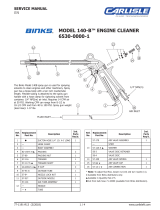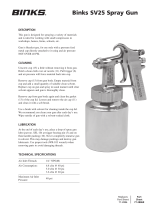
EN
77-2772-R5 (4/2019) 11 / 16 www.carlisleft.com
REPLACEMENT OF WORN PARTS
PRECAUTIONARY NOTE
Do not disassemble or work on the Binks Century LEL gun
without first doing the following:
1. Shut off the fluid pumps and air supply.
2. Release the fluid pressure in the gun and the entire system.
3. Remove the gun from fluid hoses.
If you do not follow these steps you may injure yourself and/or
nearby personnel.
REPLACING THE CATALYST NEEDLE PACKING
1. Using two standard screwdrivers, remove the trigger stud
(31), the trigger screw (32), the trigger (33), and the chopper
trigger assembly (56).
2. Unscrew the catalyst packing nut (23) with a 3/8" wrench
and pull the catalyst needle assembly (19) straight back until
it comes out of the gun head. Be sure to pull the needle out
without bending it up or down or side to side as this will
cause the needle to bend, thus ruining the needle.
3. Clean the needle assembly so that you may be able to
clearly identify the packing (21).
4. The packing is the only non-metal piece of the needle
assembly and is white in color. Note its location and orienta-
tion on the wire of the needle. Cut the worn packing away
with a sharp knife being sure not to scratch or deform any
nearby parts.
5. Carefully spread the new packing apart, about 3/64" at the
edge (this can be done easily with an X-acto type knife) and
press the packing onto the wire of the needle assembly in
the same location and orientation as noted in step 4. Gently
squeeze the packing closed with fingers.
6. Slide the packing forward and back with your fingers to
assure a proper fit onto the wire.
7. Reassemble in reverse order.
REPLACING THE CATALYST SEAT
1.
Repeat steps 1 thru 4 from section “Replacing the Resin
Needle Packing”.
2. Unscrew the catalyst packing nut (23) with a 3/8" wrench
and pull the catalyst needle assembly (19) straight back until
it comes out of the gun head. Be sure to pull the needle out
without bending it up or down or side to side as this will
cause the needle to bend, thus ruining the needle.
3. Place gun head on a flat clean surface with the back of the
gun head against the surface. This will require a hole or
recess in the surface such that the alignment cone on the
back of the gun head does not rest against anything.
4. Align a 5/64" dowel pin (available in Repair Kit
106-1252) with the hole in the center groove of the gun
head. Move the dowel pin straight down into the hole until it
seats against the catalyst seat (18), this will be about 3/16"
from the surface of the gun head with the three large
grooves. Press the seat out. This is most easily done on a
drill press or arbor press.
5. Now place the front of the gun head against a flat clean surface
such that the surface of the gun head that has the three large
grooves seats against the flat surface. This will require a hole or
recess such that the front boss of the gun head doesn’t rest
against anything. A 1" diameter by 1" deep hole will suffice.
6. Put the new catalyst seat into the hole of the gun head that
the catalyst needle assembly came out of. The small end of
the catalyst seat must go in first. The seat should drop down
into the gun head.
7. The seat now needs to be pressed into place such that a
tight fit is created between the resin seat and the walls of
the gun head that retain it. Use a 1/4" diameter dowel
to press the seat tight. Be careful not to scratch the walls
of the gun head. A drill press or arbor press is best for
this operation.
8. Reassemble in reverse order.
REPLACING THE RESIN SEAT
1. Remove air/catalyst cap retainer ring (1), air/catalyst cap
(2), the fluid nozzle (3), and the two o-rings (4 & 5) from
the gun head.
2. Pull the trigger (33) to
unseat the needle from
the seat (8) and lock the
trigger open with the
locking block (38). Using
a 1/4" hex key, loosen the
head insert about 3 turns,
leaving about 3 or so
turns engagement in the
gun head.
3. Insert a 1/4" dowel pin in the front of the head insert and
use it to press the seat out of the head insert. Finish remov-
ing the head insert with the 1/4" hex key, allowing the seat
to fall out. Remove the seal (9) and replace with a new seal.
Alternate method: remove the head insert completely before
pressing the seat out. The head insert will have to rest on a
flat surface centered over a hole between 0.410" and 0.490"
diameter to give the seat clearance to fall out.
4. Now place the front of the head insert against a flat
clean surface.
5. Put the new resin seat into the tapered hole of the head
insert. The small end of the resin seat must go in first. The
seat now needs to be pressed in place such that a tight fit is
created between the resin seat and the walls of the head
insert that retain it. Use 3/8" diameter dowel pin (available
in Repair Kit 106-1252) to press the seat tight. A drill
press or arbor press is best for this operation.
6. Reassemble in reverse order.
REPLACING THE RESIN NEEDLE PACKING
1. Remove the button head screw (40) that retains the guard
assembly (34) by using a 3/16" hex key; remove the guard
assembly.
2. Using two standard screwdrivers, remove the trigger
stud (31), the trigger screw (32), the trigger (33), and the
chopper trigger assembly (56).
3. Using 3/8" wrench or socket, remove the head retainer (51).
4. Slide the gun head (10) as far forward as it will go with your
hands. Do not use excessive force.
5. Unscrew the resin packing nut (15) with a 3/8" wrench and
pull the resin needle assembly (11) straight back until it
comes out of the gun head. Be sure to pull the needle out
without bending it up or down or side to side as this will
cause the needle to bend, thus ruining the needle.
6. Clean the needle assembly so that you may be able to clear-
ly identify the packing (13).
NOTE
The cone face of the packing should point towards the
needle point of the needle assembly.
SEAT (8)
(Continued)



















